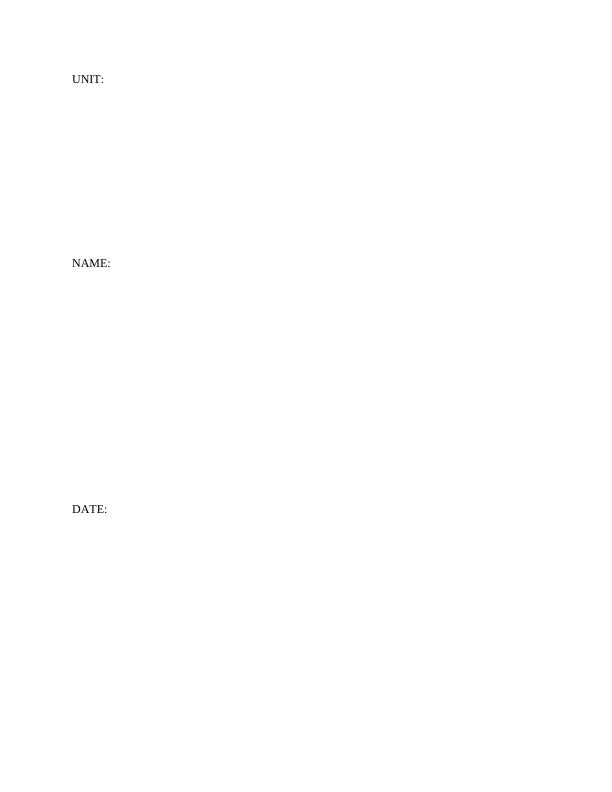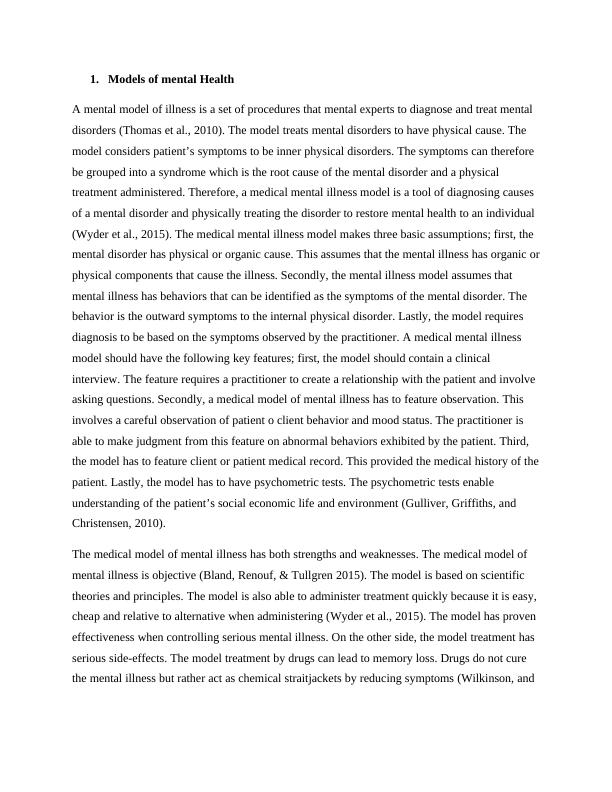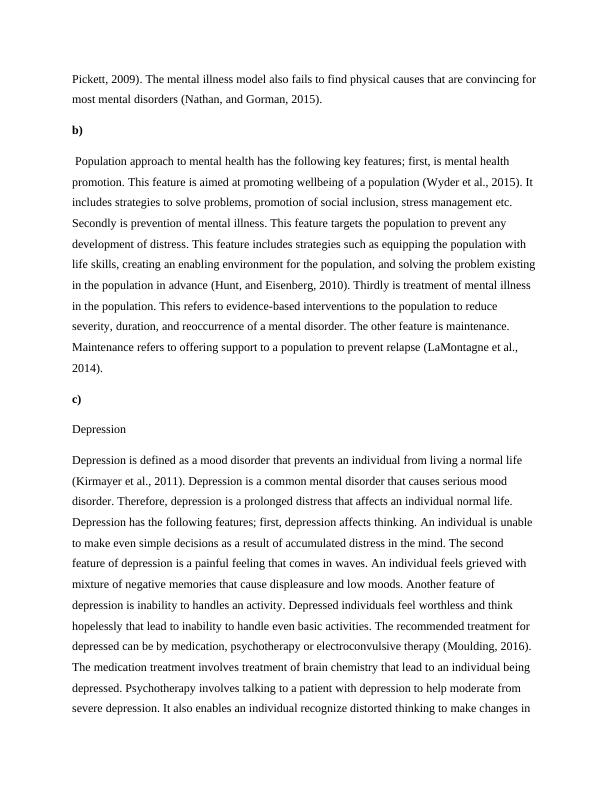Assignment on Models of Mental Health
Added on 2020-05-04
10 Pages3502 Words119 Views
UNIT:
NAME:
DATE:
NAME:
DATE:

1. Models of mental Health
A mental model of illness is a set of procedures that mental experts to diagnose and treat mental
disorders (Thomas et al., 2010). The model treats mental disorders to have physical cause. The
model considers patient’s symptoms to be inner physical disorders. The symptoms can therefore
be grouped into a syndrome which is the root cause of the mental disorder and a physical
treatment administered. Therefore, a medical mental illness model is a tool of diagnosing causes
of a mental disorder and physically treating the disorder to restore mental health to an individual
(Wyder et al., 2015). The medical mental illness model makes three basic assumptions; first, the
mental disorder has physical or organic cause. This assumes that the mental illness has organic or
physical components that cause the illness. Secondly, the mental illness model assumes that
mental illness has behaviors that can be identified as the symptoms of the mental disorder. The
behavior is the outward symptoms to the internal physical disorder. Lastly, the model requires
diagnosis to be based on the symptoms observed by the practitioner. A medical mental illness
model should have the following key features; first, the model should contain a clinical
interview. The feature requires a practitioner to create a relationship with the patient and involve
asking questions. Secondly, a medical model of mental illness has to feature observation. This
involves a careful observation of patient o client behavior and mood status. The practitioner is
able to make judgment from this feature on abnormal behaviors exhibited by the patient. Third,
the model has to feature client or patient medical record. This provided the medical history of the
patient. Lastly, the model has to have psychometric tests. The psychometric tests enable
understanding of the patient’s social economic life and environment (Gulliver, Griffiths, and
Christensen, 2010).
The medical model of mental illness has both strengths and weaknesses. The medical model of
mental illness is objective (Bland, Renouf, & Tullgren 2015). The model is based on scientific
theories and principles. The model is also able to administer treatment quickly because it is easy,
cheap and relative to alternative when administering (Wyder et al., 2015). The model has proven
effectiveness when controlling serious mental illness. On the other side, the model treatment has
serious side-effects. The model treatment by drugs can lead to memory loss. Drugs do not cure
the mental illness but rather act as chemical straitjackets by reducing symptoms (Wilkinson, and
A mental model of illness is a set of procedures that mental experts to diagnose and treat mental
disorders (Thomas et al., 2010). The model treats mental disorders to have physical cause. The
model considers patient’s symptoms to be inner physical disorders. The symptoms can therefore
be grouped into a syndrome which is the root cause of the mental disorder and a physical
treatment administered. Therefore, a medical mental illness model is a tool of diagnosing causes
of a mental disorder and physically treating the disorder to restore mental health to an individual
(Wyder et al., 2015). The medical mental illness model makes three basic assumptions; first, the
mental disorder has physical or organic cause. This assumes that the mental illness has organic or
physical components that cause the illness. Secondly, the mental illness model assumes that
mental illness has behaviors that can be identified as the symptoms of the mental disorder. The
behavior is the outward symptoms to the internal physical disorder. Lastly, the model requires
diagnosis to be based on the symptoms observed by the practitioner. A medical mental illness
model should have the following key features; first, the model should contain a clinical
interview. The feature requires a practitioner to create a relationship with the patient and involve
asking questions. Secondly, a medical model of mental illness has to feature observation. This
involves a careful observation of patient o client behavior and mood status. The practitioner is
able to make judgment from this feature on abnormal behaviors exhibited by the patient. Third,
the model has to feature client or patient medical record. This provided the medical history of the
patient. Lastly, the model has to have psychometric tests. The psychometric tests enable
understanding of the patient’s social economic life and environment (Gulliver, Griffiths, and
Christensen, 2010).
The medical model of mental illness has both strengths and weaknesses. The medical model of
mental illness is objective (Bland, Renouf, & Tullgren 2015). The model is based on scientific
theories and principles. The model is also able to administer treatment quickly because it is easy,
cheap and relative to alternative when administering (Wyder et al., 2015). The model has proven
effectiveness when controlling serious mental illness. On the other side, the model treatment has
serious side-effects. The model treatment by drugs can lead to memory loss. Drugs do not cure
the mental illness but rather act as chemical straitjackets by reducing symptoms (Wilkinson, and

Pickett, 2009). The mental illness model also fails to find physical causes that are convincing for
most mental disorders (Nathan, and Gorman, 2015).
b)
Population approach to mental health has the following key features; first, is mental health
promotion. This feature is aimed at promoting wellbeing of a population (Wyder et al., 2015). It
includes strategies to solve problems, promotion of social inclusion, stress management etc.
Secondly is prevention of mental illness. This feature targets the population to prevent any
development of distress. This feature includes strategies such as equipping the population with
life skills, creating an enabling environment for the population, and solving the problem existing
in the population in advance (Hunt, and Eisenberg, 2010). Thirdly is treatment of mental illness
in the population. This refers to evidence-based interventions to the population to reduce
severity, duration, and reoccurrence of a mental disorder. The other feature is maintenance.
Maintenance refers to offering support to a population to prevent relapse (LaMontagne et al.,
2014).
c)
Depression
Depression is defined as a mood disorder that prevents an individual from living a normal life
(Kirmayer et al., 2011). Depression is a common mental disorder that causes serious mood
disorder. Therefore, depression is a prolonged distress that affects an individual normal life.
Depression has the following features; first, depression affects thinking. An individual is unable
to make even simple decisions as a result of accumulated distress in the mind. The second
feature of depression is a painful feeling that comes in waves. An individual feels grieved with
mixture of negative memories that cause displeasure and low moods. Another feature of
depression is inability to handles an activity. Depressed individuals feel worthless and think
hopelessly that lead to inability to handle even basic activities. The recommended treatment for
depressed can be by medication, psychotherapy or electroconvulsive therapy (Moulding, 2016).
The medication treatment involves treatment of brain chemistry that lead to an individual being
depressed. Psychotherapy involves talking to a patient with depression to help moderate from
severe depression. It also enables an individual recognize distorted thinking to make changes in
most mental disorders (Nathan, and Gorman, 2015).
b)
Population approach to mental health has the following key features; first, is mental health
promotion. This feature is aimed at promoting wellbeing of a population (Wyder et al., 2015). It
includes strategies to solve problems, promotion of social inclusion, stress management etc.
Secondly is prevention of mental illness. This feature targets the population to prevent any
development of distress. This feature includes strategies such as equipping the population with
life skills, creating an enabling environment for the population, and solving the problem existing
in the population in advance (Hunt, and Eisenberg, 2010). Thirdly is treatment of mental illness
in the population. This refers to evidence-based interventions to the population to reduce
severity, duration, and reoccurrence of a mental disorder. The other feature is maintenance.
Maintenance refers to offering support to a population to prevent relapse (LaMontagne et al.,
2014).
c)
Depression
Depression is defined as a mood disorder that prevents an individual from living a normal life
(Kirmayer et al., 2011). Depression is a common mental disorder that causes serious mood
disorder. Therefore, depression is a prolonged distress that affects an individual normal life.
Depression has the following features; first, depression affects thinking. An individual is unable
to make even simple decisions as a result of accumulated distress in the mind. The second
feature of depression is a painful feeling that comes in waves. An individual feels grieved with
mixture of negative memories that cause displeasure and low moods. Another feature of
depression is inability to handles an activity. Depressed individuals feel worthless and think
hopelessly that lead to inability to handle even basic activities. The recommended treatment for
depressed can be by medication, psychotherapy or electroconvulsive therapy (Moulding, 2016).
The medication treatment involves treatment of brain chemistry that lead to an individual being
depressed. Psychotherapy involves talking to a patient with depression to help moderate from
severe depression. It also enables an individual recognize distorted thinking to make changes in

End of preview
Want to access all the pages? Upload your documents or become a member.
Related Documents
Mental and behavioral Disorders Accountlg...
|11
|3205
|34
Mental Illness and Mental Health Recoverylg...
|10
|2976
|384
PRINCIPLES OF MENTAL HEALTH NURSINGlg...
|11
|3487
|72
NURS501 - Integrated Nursing Concepts Reportlg...
|6
|1494
|42
Psychiatric Disorders: Types, Symptoms, and Treatmentlg...
|6
|2068
|4
Mental Health for Older Adults: Implications of Electroconvulsive Therapylg...
|12
|3254
|482
